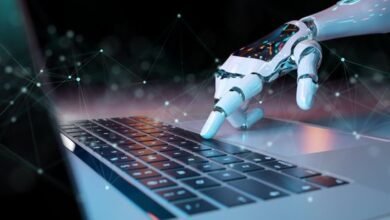Artificial Intelligence Engineering – Unlocking Tomorrow’s Innovations

Artificial Intelligence (AI) engineering is an extreme field that has transformed how we interact with technology. AI, from self-driving to assistants, has become essential to our daily lives. Embarking on the exciting journey into Artificial Intelligence Engineering, our journey begins with a canvas painted by the fusion of human ingenuity and technological intelligence.
This invites you to explore the stunning description of AI’s evolution, from its modest origins to its current force. The possibilities set the stage for deepening the applications, challenges, and symbiotic between humans and AI. As we step into the labyrinth of AI engineering, expect a narrative that exceeds the mundane, kindling interest and fostering a profound understanding of the dynamic interplay between innovation and our ever-evolving technological landscape.
Evolution of AI
The evolutionary saga of Artificial Intelligence (AI) unfolds as a captivating narrative, tracing its roots from rudimentary rule-based systems to the complex neural networks that underpin contemporary AI marvels. Beginning with the humility of early AI, this evolution mirrors a relentless pursuit of replicating human intelligence within machines.
Initially confined to specific tasks, AI’s gradual metamorphosis witnessed breakthroughs in machine learning algorithms, propelling it beyond predefined boundaries. As algorithms matured, AI systems evolved from rule-bound simplicity to today’s dynamic adaptability.

The timeline showcases the resilience of AI engineers and researchers, navigating through challenges, pitfalls, and paradigm shifts. From symbolic reasoning to statistical learning, the evolution of AI reflects a continual quest for efficiency, accuracy, and versatility.
Acknowledging the historical context of AI’s development inspires its transformative power, with each phase contributing to the present-day landscape where AI is an integral part of various industries. This journey through AI’s evolution is not just a historical account; it serves as a testament to human interest and innovation, setting the stage for an ever-expanding horizon of possibilities.
Applications
The realm of (AI) unveils an exciting of applications far outside conventional limits into the material of everyday life. From healthcare’s diagnostic prowess to the analytics and the entertainment industry’s experiences, AI’s effect is as diverse. It’s a technological tool and an avant-garde force improving efficiency, originality, and problem-solving across sectors.
AI has become a way to analyze complex medical data to aid in exact diagnoses and personalized treatment plans. Financial sectors leverage AI’s predictive prowess for risk review and investment strategies, navigating markets with exceptional insight. Meanwhile, AI-driven recommendations, virtual reality experiences, and creative collaborations transform entertainment.

The applications are not to these domains; they permeate agriculture, education, and social platforms, enhancing efficiency and enriching user experiences. This section unravels the multifaceted impact of AI applications, illustrating how this technological marvel transcends boundaries to redefine and elevate myriad facets of our interconnected world. From optimizing processes to fostering innovation, AI’s applications are a testament to its transformative influence on the diverse tapestry of human endeavors.
AI in Engineering
The symbiotic alliance between Artificial Intelligence (AI) and engineering manifests as an avant-garde collaboration where algorithms and innovation converge to redefine the essence of problem-solving and efficiency. AI functions as an ingenious orchestrator in engineering, optimizing processes, predicting maintenance needs, and instigating a paradigm shift in design methodologies. It’s not merely a tool but an indispensable partner, augmenting human ingenuity to navigate complexities.
AI in engineering extends beyond automation, catalyzing creativity and optimization. From streamlining manufacturing workflows to enhancing product designs through generative algorithms, this transforms how we conceptualize, create, and iterate. This section delves into the dynamic interplay between AI and engineering, unraveling how this technological tandem propels us into an era where innovation is not just a product but an ever-evolving process continually enriched by the fusion of artificial intelligence and human expertise.
Role of Machine Learning
In the complex relationship between human understanding and technological advancement, machine learning (ML) is a transformative force that redefines how artificial intelligence understands, learns, and adapts. Beyond a mere set of algorithms, ML becomes the cognitive engine propelling AI’s evolution. It delves into the nuances of data, unraveling patterns and making decisions with a depth that mirrors human learning.
Machine Learning doesn’t merely follow pre-set rules; it dynamically refines itself, adjusting and improving based on experiences. This section navigates the landscape of ML, exploring how it empowers AI systems to recognize speech and make decisions in complex scenarios.

It’s not just a tool; it’s the cognitive backbone reshaping the possibilities of AI, opening doors to innovation that goes beyond programmed responses, allowing AI to evolve, learn, and adapt in ways that mirror the intricate tapestry of human thought.
Challenges in AI Engineering
Navigating the frontier of Artificial Intelligence (AI) engineering unveils a landscape adorned with challenges, where the promise of innovation meets the complexities of ethical considerations and the perpetual pursuit of improvement. These challenges are not roadblocks but invitations to innovation, demanding a delicate balance between progress and moral responsibility.
From addressing biases in algorithms to ensuring AI aligns with societal values to the intricate challenges AI engineers face. Where the goal of technological excellence twists to create ethically sound and socially responsible AI solutions, assuming these challenges spark a dialogue on responsible AI development, paving the way for solutions that transcend the immediate, laying the foundation for a future where AI engineering aligns seamlessly with human values and aspirations.
Future Prospects
The canvas of artificial intelligence (AI) is an ever-evolving landscape where the brushstrokes of innovation distance outside the horizon of the present into a future teeming with options. Delving into the prospects of AI is akin to staring into a crystal ball where natural language processing develops into seamless communication, and AI models become refined and intuitive.
This section unravels the lines of tomorrow’s AI, exploring the potential of increased human capabilities, sustainable AI, and appearing technologies yet to grace the technological stage. It’s a creative journey that exceeds predictions, inviting readers to imagine a future where AI is not just a tool but an essential companion, reshaping industries, solving global challenges, and improving the human experience in courses yet unimagined.

AI and Human Collaboration
The intersection of (AI) and human collaboration marks an epoch where technology becomes an ally rather than an adversary. This section delves into the harmonious partnership between AI and humans, a collaboration beyond mere augmentation. It explores where AI, far from replacing human roles, becomes a catalyst for unlocking creativity, augmenting decision-making, and revolutionizing problem-solving.
The record navigates the coexistence of machine efficiency and human impulse, highlighting instances where AI empowers individuals to delve into empires of innovation that were once outside reach. This collaboration is not a tale of displacement but an evolving narrative where the combined ingenuity of humans and AI paves the way for a future where technical advancements align seamlessly with human aspirations, improving lives and expanding the frontiers of what is achievable.
Ethical Considerations
Moral concerns guide AI technologies’ responsible innovation and deployment in the complex web of Artificial Intelligence (AI) development. This section analyzes the potential algorithm preferences, delves into privacy concerns, and examines the ethical ramifications of AI decision-making. It’s a call to action for transparent AI development, suggesting a conscientious approach that aligns with societal values.
The discourse on ethical considerations is not a hindrance but a vital foundation. Ensuring that AI, as it advances, remains in harmony with human values, promoting fairness and transparency. The responsible use of technology in a world increasingly intertwined with the capabilities of artificial intelligence.
Impact on Job Market
The integration of Artificial Intelligence (AI) is a transformative force reshaping the job demand landscape. It’s not a narrative of displacement but a nuanced evolution where routine tasks automate, creating space demands uniquely human skills. This section explores the dynamic interplay, showcasing how AI sparks innovation and opens avenues in data analysis.

Robot jobs concept vector isometric illustration. Ai revolution in employment. Robots waiting in line together with humans for the vacant job.
While specific roles may evolve, the overall impact is where adaptability, creativity, and a symbiotic relationship with AI become pivotal. As AI collaborates, skilled individuals lead a paradigm shift in an evolving job market shaped by human ingenuity and technology.
AI Engineering Tools
In the arsenal of Artificial Intelligence (AI) engineers, tools stand as the building blocks of innovation. This section unravels the sophisticated toolkit powering AI engineering projects, exploring frameworks, libraries, and platforms that catalyze development. From TensorFlow’s prowess in machine learning to PyTorch’s flexibility, each tool is a brushstroke on the canvas of AI creativity. OpenAI’s GPT models shape natural language processing as the literary architects.
The narrative navigates through the diverse landscape of AI engineering tools, emphasizing their role in streamlining workflows, optimizing models, and fostering the experimentation crucial for cutting-edge AI solutions.
It’s not just about the tools; it’s a journey through the technological scaffolding that transforms concepts into reality. It empowers AI engineers to push boundaries, iterate, and craft solutions that redefine what is achievable in artificial intelligence.
Successful AI Engineering Projects
In Artificial Intelligence (AI) engineering, success resonates in projects that transcend innovation into real-world impact. This section spotlights exemplary projects where AI’s application isn’t just theoretical but transforms industries and solves complex problems—from healthcare breakthroughs to revolutionary advancements in autonomous systems, illustrating the tangible influence of AI engineering.
The narrative unveils the stories behind these successes, ingenious solutions, and the transformative power of AI with purpose. Success in AI engineering isn’t just a milestone; it’s limitless potential achieved through human and (AI) fusion.
Educational Pathways
Embarking on a career in Artificial Intelligence (AI) engineering demands a strategic journey through diverse educational pathways. This section navigates the avenues, from academic pursuits to hands-on projects, cultivating the skills essential for AI expertise.
It underlines the fusion of theoretical knowledge with practical application, programming languages, and machine learning conceptions.

The narrative unveils the roadmap, encouraging a holistic approach that lays the foundation for technical prowess. Educational pathways become the compass, steering individuals toward a future in AI engineering through a well-rounded learning journey.
Conclusion
In conclusion, artificial intelligence engineering is a dynamic field with immense potential. AI continues to shape our world from its evolution to current applications and prospects. As we navigate the challenges and ethical considerations, the collaboration between AI and humans opens new possibilities.
FAQs
How does AI impact job opportunities in the engineering sector?
While some tasks may be, AI creates new job opportunities in areas like AI development, data analysis, and system optimization.
What are the ethical situations surrounding AI?
Ethical situations in AI include algorithm preferences, privacy issues, and the possible misuse of AI technologies. Addressing these concerns is vital for responsible AI development.
Can AI completely replace human decision-making?
No, AI complements human decision-making. While AI can explore data and provide insights, human conclusions, creativity, and ethical considerations are essential.
How can one follow a career in AI engineering?
Following a career in AI engineering involves gaining a solid foundation in computation, programming languages, and machine learning concepts. Educational degrees and hands-on projects contribute to building expertise.








